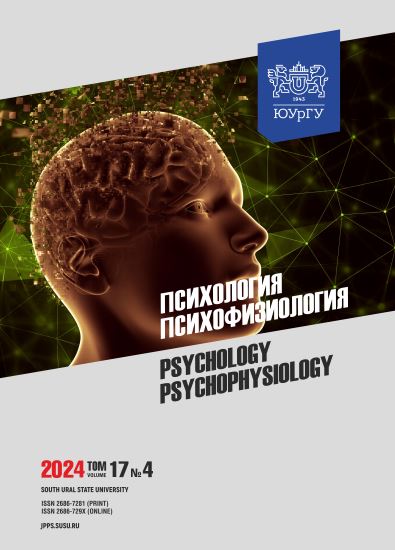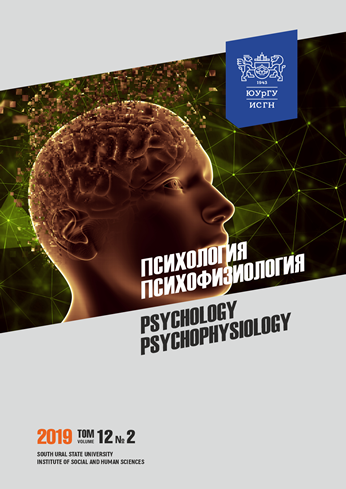Development, validation, and standardization of questionnaire measures for identifying increased anxiety in schoolchildren
Abstract
Introduction. The increasing prevalence of anxiety disorders in children necessitates the development of effective diagnostic and etiological assessment tools, particularly for manifestations in collective settings. Aim. This study aims to create a practical tool for identifying the signs and causes of increased anxiety in schoolchildren, with a view to implementing preventive measures within educational organizations.
Materials and Methods. Standardized questionnaires were developed for students, parents, and teachers. Traditional validation and standardization procedures were employed using the validity index, Kendall Rank Correlation Coefficient, Cronbach's α, and stanines. A pilot test was conducted on a sample of 256 students from grades 6, 7, 8, and 10, as well as 256 parents and 12 teachers. Results. Expert evaluation determined that questionnaires 2 (possible causes of anxiety in children), 3 (preventive measures implemented through teachers), and 4 (preventive measures implemented through parents) were reasonable and suitable in content, while questionnaire 1 (signs of anxiety) required significant revision. The questionnaires had textual variations for different respondent groups but maintained identical meaning. The language was accessible to respondents across sex and age groups. Correlation analysis of responses from children, parents, and teachers, along with assessments of questionnaire reliability, demonstrated their consistency. Standardization was implemented using stanines, with proposed variants of resulting scores and weighting coefficients for intermediate scores. Conclusion. This research provides a technique for rapid assessment of anxiety indicators in children. It offers potential benefits for organizing preventive work and evaluating its effectiveness within educational settings.
Downloads
References
2. Kapitanec E.G., Devyatova K.M. The influence of anxiety on aggressive behavior of adolescents Nauchno-metodicheskii ehlektronnyi zhurnal “Kontsept” = Concept. 2016;7:61–65. Available at: http://e-koncept.ru/2016/56090.htm (accessed: 24.05.2024) (in Russ.).
3. Malyutina O.P., Titova A.S., Mishurova A.A. The relationship between the aggressiveness in schoolchildren and the level of trait anxiety. Mezhdunarodnyi nauchno-issledovatelskii zhurnal = International Research Journal. 2022;116(2):171–174. DOI: 10.23670/IRJ.2022.116.2.064. (in Russ.).
4. Brel E.Yu., Gaiduk S.V. Problems of development of uneasiness at younger schoolboys. Sibirskii psikhologicheskii zhurnal = Siberian psychological journal. 2000;12:79–84. (in Russ.).
5. Kudinova E.A. Features, causes and types of school anxiety. Tekhnologii obrazovaniya = Technology education. 2022;16(2):134–137. (in Russ.).
6. Kochubei B.I., Novikova E.V. Ehmotsionalnaya ustoichivost shkolnika [Emotional stability of a student]. Moscow: Znanie Publ. 1988:80. (in Russ.).
7. Galchenko A.S. Methodological aspects of the development of a questionnaire aimed at determining the status of civil identity of high school students. Tendentsii razvitiya nauki i obrazovaniya = Trends in the development of science and education. 2021;75-3:121–125. (in Russ.). DOI: 10.18411/lj-07-2021-107.
8. Nikolaev A.N. Methodological recommendations for questionnaires. Vestnik Pskovskogo gosudarstvennogo universiteta = Bulletin of the Pskov State University. 2019;10:111–114. (in Russ.).
9. Prodanova Ya.P., Kundurzhiev T.G., Yancheva-Stoicheva M.G. Translation, adaptation and validation the questionnaire "quality of working life" by A.P. Egorishin for workers in healthcare organizations. Nauka i mir = Science and world. 2018;54(2-1):41–45. (in Russ.).
10. Karimova V. Assessment of the validity and reliability of the results of the questionnaire. Nauka i innovatsii = Science and innovation. 2022;1(5):118–124. (in Russ.). DOI: 10.5281/zenodo.7005916
11. Shakarimov A.K., Kopobayeva I.L., Turmukhambetova A.A., Turdybekova Ya.G. The assessment of the barriers to mens participation in perinatal care: development and validation of a questionnaire. Meditsina i ekologiya = Medicine and ecology. 2020;96(3):101–110. (in Russ.)
12. Zamanzadeh V., Ghahramanian A., Rassouli M. et al. Design and implementation content validity Study: development of an instrument for measuring patient-centered communication. Journal of Caring Sciences. 2015;4(2):165–178. DOI: 10.15171/jcs.2015.017.
13. Razuvaeva Yu.Yu., Didenko A.V. Personal anxiety in adolescents. Molodezhnyi innovatsionnyi vestnik = Youth Innovation Bulletin. 2023;12(2):336–338. (in Russ.).
14. Konovalova P.V., Petrova S.S. Methods of correction of anxiety in school-age children. Refleksiya = Reflection. 2022;6:51–54. (in Russ.).
References on translit
-Copyright (c) 2024 Psychology. Psychophysiology

This work is licensed under a Creative Commons Attribution-NonCommercial-NoDerivatives 4.0 International License.



